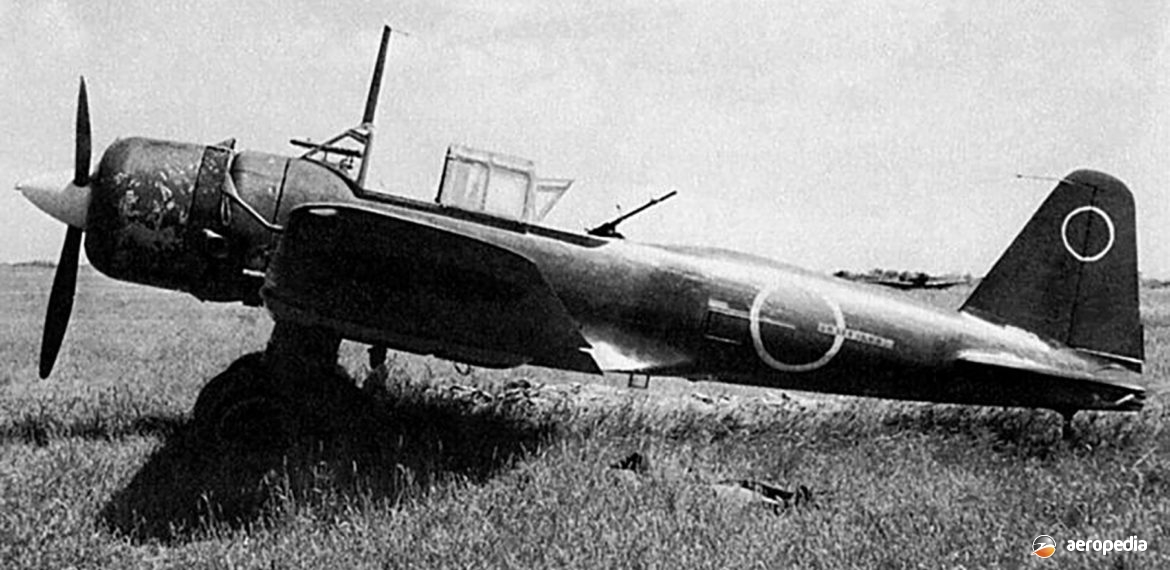Photograph:
Mitsubishi Ki-51 ‘Sonia’ during World War II in the Pacific (Author’s collection)
Country of origin:
Japan
Description:
Ground attack and reconnaissance aircraft
Power Plant:
One 709 kw (950 hp) Mitsubishi Ha-26-II fourteen-cylinder two-row air-cooled radial engine
Specifications:
- Wingspan: 12.1 m (39 ft 8⅜ in)
- Length: 9.21 m (30 ft 2 10/32 in)
- Height: 2.73 m (8 ft 11½ in)
- Wing area: 24.02 m² (258.548 sq ft)
- Max speed at 3,000 m (9,845 ft): 424 km/h (263 mph)
- Climb to 5,000 m (16,405 ft): 9 mins 55 sec
- Service ceiling: 8,270 m (27,130 ft)
- Range: 1,060 km (660 miles)
- Empty weight: 1,873 kg (4,129 lb)
- Loaded weight: 2,798 kg (6,169 lb)
- Max loaded weight: 2,920 kg (6,415 lb)
Armament:
Two wing mounted 12.7 mm (0.50 in) Type 1 machine guns and one flexible rear firing 7.7 mm (0.303 in) Type 89 machine gun; normal bomb load 250 kg (551 lb)
History:
In December 1937 a specification was issued for a ground attack aircraft to be developed from the successful Ki-30 ‘Ann’ light bomber. It was designated Ki-51 and, known to the Allies as ‘Sonia’, the first of two prototypes was completed in June 1939, the second in August 1939. Testing revealed the aircraft would be also suitable for reconnaissance duties and an example was built with the flight instruments and controls in the rear cockpit replaced by cameras, this becoming known as the Army Type 99 Tactical Reconnaissance Plane (Ki-51a). However, it was decided not to build this specialised variant and just incorporate in production aircraft the provision to fit reconnaissance equipment. In service there was no difference officially between the two variants and the aircraft were modified in the field for tactical reconnaissance or ground support missions. All 1,459 production aircraft built by Mitsubishi became known as the Army Type 99 Assault Plane.
Military operations commenced in China where the type was quite successful. To meet operational requirements, a second production line was set up at the Tachikawa facility at Kokusho, and a further 913 were built. During its production life it was modified by the installation of two 68 litre (15 Imp gal) wing leading edge fuel tanks, and the 7.7 mm (0.303 in) type 89 machine gun was replaced by the 12.7 mm (0.5 in) type 1 machine gun. The type was highly regarded by crews, being well protected, manoeuvrable, easy to fly and maintain, and could be operated from small airfields.
Late in the war a number were used for kamikaze missions carrying a 250 kg (551 lb) bomb. In 1941 engineers from the Manchurian Aeroplane Manufacturing Co Ltd (Mansyu Hikoki Seizo K K) commenced development of an advanced variant known as the Ki-71 Experimental Tactical Reconnaissance Plane with a 1,119 kw (1,500 hp) Mitsubishi Ha-112-II radial engine, with two wing mounted 20 mm Ho-5 cannon, and a retractable undercarriage, which became known as ‘Edna’ to the Allies but it was not proceeded with.
A few were abandoned at wartime strips throughout New Guinea, Java, Sumatra and the islands. A few survivors were put into service by the Indonesian Air Force. One is known to survive in an Indonesian Museum. Although used to some extent in New Guinea and the Islands, only a few wrecks have been discovered over the years. One ‘Sonia’ has been located abandoned at Bombaral Peninsula, Irian Jaya in what was Dutch New Guinea.
A ‘Sonia’ of the Japanese 73rd Independent Air Squadron was captured by members of No 4 Squadron, RAAF at Keningau on Borneo. The aircraft had its armament disabled and was painted army green on the upper surfaces and light grey on the lower surfaces, with large green ‘surrender’ crosses on both sides of the fuselage, above and below the wings, and on each side of the tail. The letters ‘DEP’ appeared in white on the fin. A number of No 4 Squadron personnel flew the aircraft before it was transferred to No 1 Squadron at Labuan in north-west Borneo. It was eventually written off after a landing accident.

